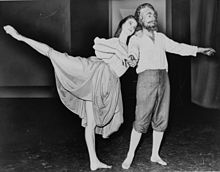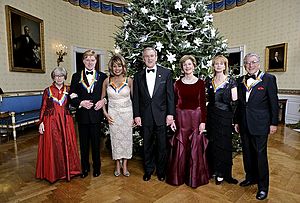
New York City Ballet (NYCB) is a ballet company founded in 1948 by choreographer George Balanchine and Lincoln Kirstein. Balanchine and Jerome Robbins are considered the founding choreographers of the company. Léon Barzin was the company's first music director. City Ballet grew out of earlier troupes: the Producing Company of the School of American Ballet, 1934; the American Ballet, 1935, and Ballet Caravan, 1936, which merged into American Ballet Caravan, 1941; and directly from the Ballet Society, 1946.

Darci Kistler is an American ballerina. She is often said to be the last muse for choreographer George Balanchine.

Arthur Mitchell was an American ballet dancer, choreographer, and founder and director of ballet companies. In 1955, he was the first African-American dancer with the New York City Ballet, where he was promoted to principal dancer the following year and danced in major roles until 1966. He then founded ballet companies in Spoleto, Washington, D.C., and Brazil. In 1969, he founded a training school and the first African-American classical ballet company, Dance Theatre of Harlem. Among other awards, Mitchell was recognized as a MacArthur Fellow, inducted into the National Museum of Dance's Mr. & Mrs. Cornelius Vanderbilt Whitney Hall of Fame, and received the United States National Medal of Arts and a Fletcher Foundation fellowship.
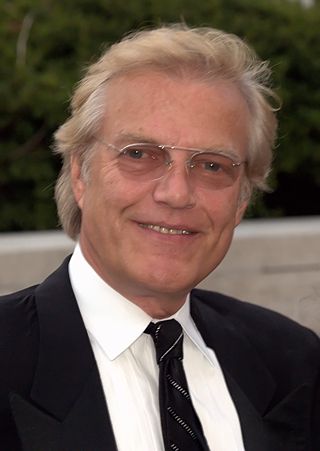
Peter Martins is a Danish former ballet dancer and choreographer. Martins was a principal dancer with the Royal Danish Ballet and with the New York City Ballet, where he joined George Balanchine, Jerome Robbins, and John Taras as balletmaster in 1981. He retired from dancing in 1983, having achieved the rank of danseur noble, becoming Co-Ballet Master-In-Chief with Robbins. From 1990 until January 2018, he was solely responsible for artistic leadership of City Ballet.
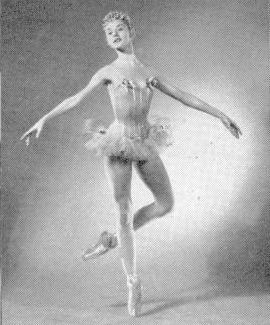
Tanaquil Le Clercq was an American ballet dancer, born in Paris, France, who became a principal dancer with the New York City Ballet at the age of nineteen. Her dancing career ended abruptly when she was stricken with polio in Copenhagen during the company's European tour in 1956. Eventually regaining most of the use of her arms and torso, she remained paralyzed from the waist down for the rest of her life.
Heather Watts is a former ballet dancer and teacher most known for her time with the New York City Ballet.
Jewels is a three-act ballet created for the New York City Ballet by co-founder and founding choreographer George Balanchine. It premièred on Thursday, 13 April 1967 at the New York State Theater, with sets designed by Peter Harvey and lighting by Ronald Bates.
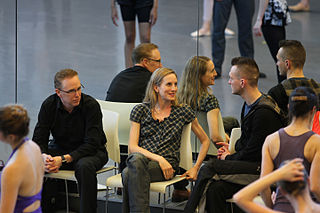
Wendy Whelan is an American ballet dancer. She was principal dancer with the New York City Ballet and performed with the company for 30 years, and toured in the U.S., Europe, and Asia. Whelan has also been an influential guest artist with Morphoses/The Wheeldon Company. In 2019, Whelan was named Associate Artistic Director of New York City Ballet.
The Suzanne Farrell Ballet is a ballet company housed at the Kennedy Center, Washington, D.C., and founded in 2000 by Suzanne Farrell, one of George Balanchine's most celebrated ballerinas, and a former New York City Ballet principal dancer. Until 2017, the Suzanne Farrell Ballet was a full-fledged company produced by the Kennedy Center and had performed there since 1999 in addition to presenting extensive national and international tours. In September 2016, the Center announced that the company would be disbanding at the end of 2017, citing "possibilities of new expansion" and indicating that Farrell would likely return to "full-time teaching."

Episodes is a ballet choreographed by Martha Graham and George Balanchine, to compositions by Anton Webern. The ballet was a co-production between the Martha Graham Dance Company and Balanchine's New York City Ballet (NYCB). Though it was conceived to be a collaboration between Graham and Balanchine, leading choreographers in modern dance and neoclassical ballet respectively, they ultimately worked separately on the ballet's two halves. Episodes I was choreographed by Graham, for dancers from her company and four NYCB members, and depicts Mary, Queen of Scots remembering the events in her life before her execution. Episodes II, by Balanchine, is completely plotless, and made for members of the NYCB and Graham dancer Paul Taylor, who originated a solo. The ballet uses all seven orchestral compositions by Webern.
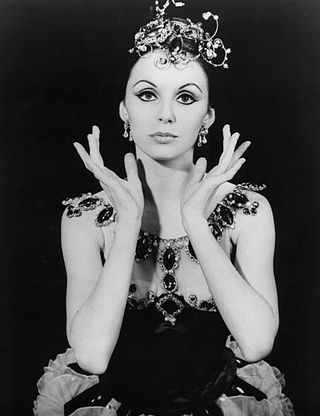
Patricia McBride is a ballerina who spent nearly 30 years dancing with the New York City Ballet. McBride joined the New York City Ballet in 1959. She became a principal in 1961, becoming the company's youngest principal. She danced with the company for 30 years, including roles created for her by choreographers George Balanchine and Jerome Robbins.
Mozartiana is a ballet choreographed by George Balanchine to Tchaikovsky's Orchestral Suite No. 4, Mozartiana. The current version of the ballet was made for New York City Ballet's Tchaikovsky Festival, and premiered on June 4, 1981, at the New York State Theater. It is considered Balanchine's last major work.

Kay Mazzo is an American former ballet dancer and educator. In 1961, she joined Jerome Robbins' company, Ballets USA. The following year, she joined the New York City Ballet and was promoted to principal dancer in 1969. She created roles for George Balanchine and Robbins, before retiring from performing in 1981. She then joined the permanent faculty of the School of American Ballet in 1983, named co-chairman of faculty in 1997 and chair of faculty in 2018. She stepped down from the position in June 2022, but continues to teach.
Vienna Waltzes is a ballet choreographed by George Balanchine to music by Johann Strauss II, Franz Lehár and Richard Strauss, made as a tribute to Austria. It premiered on June 23, 1977 at the New York State Theater, performed by the New York City Ballet, and was an immediate success among the public.

Holly Hynes is an accomplished, award-winning costume designer with over 250 ballets to her credit, including more than 70 at the New York City Ballet. Hynes' designs are also on view in companies around the world, including American Ballet Theatre, San Francisco Ballet, Bolshoi Ballet, National Ballet of Canada, Kirov Ballet, Royal Ballet, Paris Opera Ballet, Royal Danish Ballet, La Scala Theatre Ballet, Koninklijk Ballet van Vlaanderen, Houston Ballet, BalletMet, Pennsylvania Ballet, Ballet Vancouver, Les Grands Ballets Canadiens, American Repertory Ballet, Pacific Northwest Ballet, Atlanta Ballet, Richmond Ballet, Nashville Ballet, Miami City Ballet, Alberta Ballet, Joffrey Ballet, Kansas City Ballet, and the Suzanne Farrell Ballet at The John F. Kennedy Center for the Performing Arts, where she served as the resident costume designer for 19 years.

Allegro Brillante is a ballet choreographed by George Balanchine to Tchaikovsky's Piano Concerto No. 3. The ballet is danced by a principal couple and a corps de ballet of eight. Balanchine said it "contains everything I knew about classical ballet." Allegro Brillante was made for the New York City Ballet, and premiered on March 1, 1956, at the City Center of Music and Drama, with Maria Tallchief and Nicholas Magallanes originating the two principal roles.

Aesha Ash is an American ballet dancer and teacher. She danced numerous leading roles as a member of New York City Ballet's corps de ballet and as a soloist with Béjart Ballet and Alonzo King LINES Ballet, and Morphoses/The Wheeldon Company. Following her retirement from performing, she founded The Swan Dreams Project in 2011 to dispel stereotypes about Black women in ballet. In 2020, she became the first African American female faculty member at the School of American Ballet.
Georgina Pazcoguin is an American ballerina. She is a soloist with the New York City Ballet, and is known for challenging racism in ballet, and for performing on Broadway.
Movements for Piano and Orchestra is a neoclassical ballet choreographed by George Balanchine to Stravinsky's score of the same name. The ballet premiered on April 9, 1963, at City Center of Music and Drama, performed by the New York City Ballet. Though the two lead roles were created for Diana Adams and Jacques d'Amboise, seventeen-year-old Suzanne Farrell danced the female lead at the premiere due to Adams' pregnancy. Starting in 1966, Movements and Monumentum pro Gesualdo (1960) are performed together.
Duo Concertant is a ballet choreographed by George Balanchine to Stravinsky's score of the same name. The ballet was created for New York City Ballet's Stravinsky Festival, a tribute to the composer a year after his death, and premiered on June 22, 1972, at the New York State Theater, danced by Kay Mazzo and Peter Martins.


